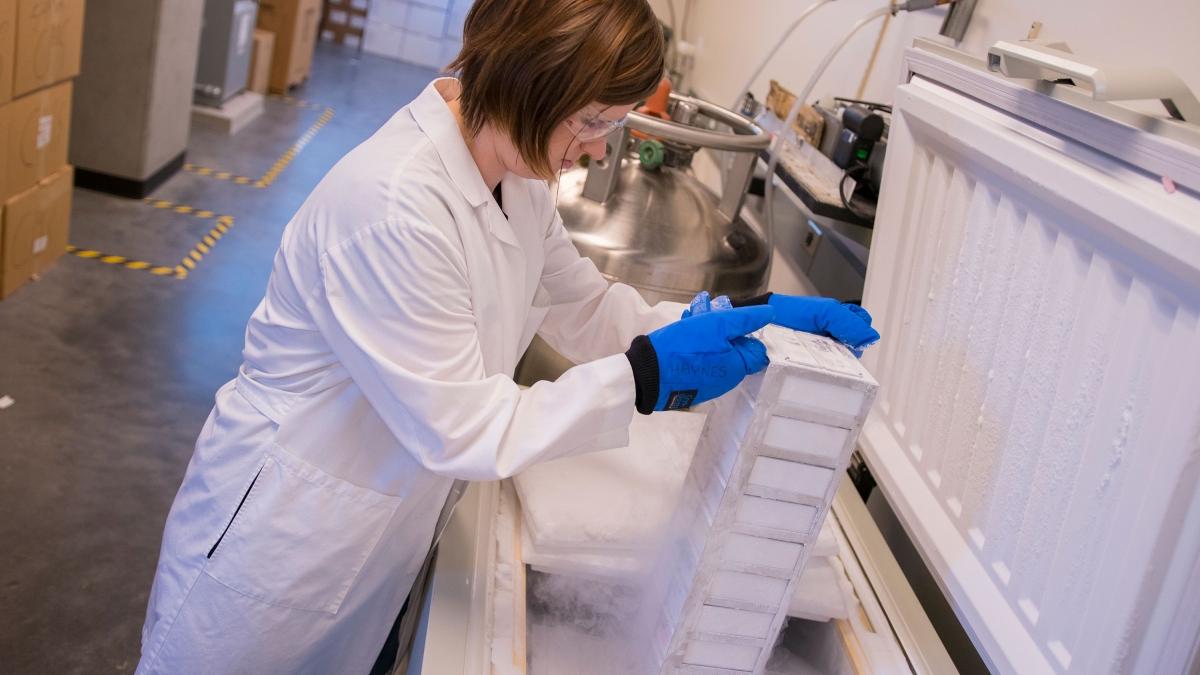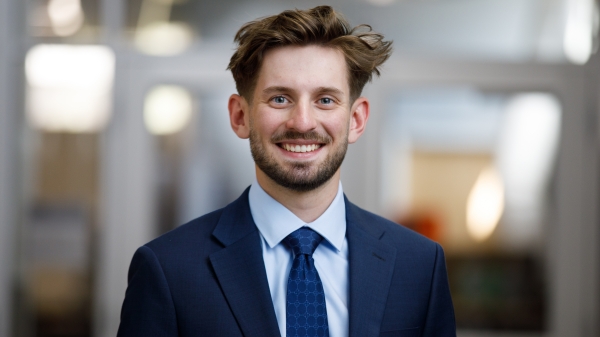Synthetic biology sparks promise of medical, energy advances

Cassandra Barrett, a graduate research associate in Assistant Professor Karmella Haynes’ synthetic biology lab, checks on engineered cell cultures stored in a deep freezer set at -150 degrees Celsius. Barrett is pursuing a doctoral degree in biological design in the School of Biological and Health Systems Engineering, one of ASU’s Ira A. Fulton Schools of Engineering. Photo by Marco Alexis-Chaira/ASU
If synthetic biology can “catch fire,” few areas of science and engineering could match it for having as dramatic an impact across such a broad a range of human needs.
That’s the prediction from Karmella Haynes, an Arizona State University assistant professor of biomedical engineering. The field has yet to build the critical momentum necessary to fulfill that potential, said Haynes, but when it does, she thinks “it will basically make all of bioengineering better.”
She and her synthetic biology research colleagues are confident advances within their reach will help provide solutions to an array of challenges in medicine, health care, fuel production, energy, environmental protection, industrial processes and much more.
Those possibilities were explored recently at the 2018 Synthetic Biology: Engineering, Evolution and Design gathering called the SEED conference, hosted by the American Institute of Chemical Engineers.
Haynes co-chaired the event held in Scottsdale, not far from ASU’s Tempe campus, which drew more than 400 attendees, including industry representatives, government agency leaders, academics and researchers from many major universities across the United States, as well as faculty members from research universities in Europe, Canada and Mexico.
SEED 2018 was one of the largest meetings yet of the synthetic biology community and one that participants say also demonstrated the field’s robust acceleration.
“It was a strong showing that our community has been maturing marvelously over the past decade and a half,” said James Collins, a professor of biological engineering at the Massachusetts Institute of Technology and a pioneer in the synthetic biology field. He was a keynote speaker at SEED 2018.
Programming biomaterials for beneficial purposes
Conference presentations revealed strides being made on several major application fronts, in particular in biomedicine and the expansion of biology-based tools that can be employed in research, Collins reported.
Besides expertise in various facets of biology and biotechnology, researchers are drawing on chemistry, computer science and genetic, molecular, electrical and systems engineering to examine how to construct biological systems in new ways that maximize the functions those systems are capable of performing.
“It’s essentially putting living systems to work, designing them and programming them at the cellular level,” Haynes explained.
Such biological pathways could be programmed to direct the body’s immune system to more aggressively attack diseases or repair damaged body tissues, or to produce biofuels that are cleaner and renewable or to genetically enhance crops, Haynes said.
At the SEED conference, discussions and presentations focused on questions researchers are trying to answer about how genes, proteins, chromosomes, DNA and the like can be synthesized and made to behave predictably for productive and beneficial purposes.
Work by Haynes and other faculty members in ASU’s Ira A. Fulton Schools of Engineering and the Biodesign Institute covers some of the main thrusts of these pursuits.
Enhancing the body’s ability to heal itself
Associate Professor Xiao Wang is working on design, modeling and engineering of novel gene-regulation networks — groups of interacting genes that together dictate the function of cells. His goal is to better understand what triggers the cell differentiation process that takes place within those networks and causes stem cells to transform into the kinds of specialized cells critical to the functioning of essential bodily systems.
Wang’s lab is looking for ways to more effectively determine “cell fate.” Controlling these transformations could make it possible to produce cells designed specifically to repair tissues and organs or treat infections and diseases.
Gene-editing tools for better therapeutics
Assistant Professor Samira Kiani uses synthetic biology techniques to control when, where and how genes in the body can be modulated, or adjusted, to perform safe and controllable gene therapies.
Using CRISPR, short for Clustered Regularly Interspaced Short Palindromic Repeats, an advanced DNA- and gene-editing tool, Kiani wants to ensure CRISPR-based therapies can be made safer and more effective for correcting genetic or acquired diseases.
Kiani’s focus is on engineering biological “safety switches” that enable CRISPR to generate targeted therapeutic treatments while preventing toxicity or other unwanted consequences from emerging during the process.
New products to boost bio-based industries
Combining metabolic and bioprocess engineering with synthetic biology and microbiology, Associate Professor David Nielsen’s lab team is striving to overcome technological barriers that are limiting the potential to produce bio-derived fuels and chemicals.
The effort includes developing new biotechnologies that convert renewable biomaterials at the microbial level into biofuels and biochemicals.
Nielsen’s research is advancing the engineering of what he calls “microbial chemical factories” to synthesize novel bioproducts, and he’s developing strategies for carbon and energy conservation to enhance yields of those products from biomaterials.
His team is engineering microbes with characteristics and capabilities that will prove valuable to bio-industries — for example, microbes that would be key ingredients in bioprocessing methods that enable biochemicals to be produced more economically.
Exploring regenerative possibilities
Assistant Professor Mo Ebrahimkhani is trying to find ways to trigger body tissue regeneration by essentially “writing” gene-regulation networks onto human cells. Those regulatory networks would then program cells to generate new tissues for internal organs.
His team is concentrating on studies of the human liver because of its distinctive regenerative capacity. They hope to create a platform for the development of new regenerative therapies, as well as for drug testing and gaining a better understanding of the mechanisms of human diseases.
Ebrahimkhani expects the outcome to be “tools, technology and treatment approaches that will set the stage for a new way to perform regenerative therapy in humans. We will add a new dimension to the field of tissue engineering to program the generation of new tissue from the inside out.”
Empowering proteins as defense mechanisms
Haynes’ research projects include developing synthetic proteins that can perform a range of biomedical functions. These proteins could provide a safer and more effective method of injecting medicinal drugs into specific locations in the body.
Synthetic biology techniques could also be used to make certain proteins produced by our bodies able to battle cancer and other diseases more effectively than the chemical compounds widely used in current drugs, Haynes said.
Modeling methods of fighting off infectious disease
Cheryl Nickerson, a professor in ASU’s Schools of Life Science, conducts her research in the Center for Immunotherapy, Vaccines and Virotherapy at ASU’s Biodesign Institute. She is leading work that combines microbiology, tissue engineering and physics to understand the dynamic interactions between a host, its microenvironment and the microbial pathogens that lead to infection and disease.
Her team has developed innovative model pathogenesis systems to study these interactive processes, including 3D tissue culture models as predictive human surrogate platforms to study host-pathogen interactions and disease mechanisms, and characterizing mechanotransduction responses of pathogens to physiological fluid forces naturally encountered during infection and in the microgravity environment of spaceflight.
In addition to such advances in disease modeling and therapeutics, Nickerson said, these models can provide powerful research tools for developing treatments of infectious diseases using synthetic biology techniques.
Student forsees life-enhancing impacts
The diverse opportunities synthetic biology offers to improve the quality of life drew Cassandra Barrett into the field. After earning a degree in microbiology from the University of Minnesota, she is now pursuing a doctoral degree in the Fulton Schools' biological design program and is a research associate in Haynes’ lab.
In synthetic biology, Barrett sees the promise of pathways to enriching agriculture and the nutritional value of foods, reducing plastic and petroleum waste, making industrial production more innovative and less harmful to the environment, and even providing more efficient data storage systems.
Barrett is planning for a career in genetic medicine.
“I want to implement genetic medicines in a way that is responsible, ethical and equitable,” she said.
ASU courses that delve into synthetic biology are drawing not only biomedical engineering students but also those majoring in biological sciences, computer science, other branches of engineering and even business and humanities.
“That reflects the nature of the field. The overall impact will be broad and substantial,” Haynes added.
Ambitions and hopes running high
The 2018 SEED conference also reflected the wide-ranging possibilities of synthetic biology, said Nickerson, who gave a talk at the event.
“It was an excellent opportunity to interact with scientists from highly multidisciplinary backgrounds that spanned academia, government and corporate entities and a terrific platform for researchers to network interact with others looking for new synergistic applications and cutting-edge technologies,” Nickerson said.
Representatives from government, business and industry at the SEED conference gave researchers “insight into how their work aligns with the need for advances in synthetic biology among those groups.”
“Interest from industry is active and growing because they’re seeing a mix of clinical and industrial applications that are really edging close to fruition,” said Collins, who works with the Wyss Institute for Biologically Inspired Engineering at Harvard University.
Synthetic biology is poised to more strongly assert its ability to boost major parts of the economy — particularly in bioenergy, food, environmental management and the next generation of medical diagnostics and therapeutics.
“We are showing that we can use synthetic biology to address real-world problems in unique ways,” Collins said.
There’s been steady progress in moving advances out of the lab and into application in commercial enterprises, said Julius Lucks, an associate professor of chemical and biological engineering at Northwestern University who will co-chair the 2019 SEED conference in New York City.
“We’re seeing the emergence of some very exciting companies in the metabolic engineering and strain engineering areas that are starting to deliver on some of the early promises of our field,” Lucks said.
By hosting this year’s conference, ASU faculty members and administrators were able to show their state-of-the-art research facilities and projects to representatives of potential funding sources, including the National Science Foundation, the National Institutes of Health, the U.S. Department of Defense and its research agency.
It was a welcome opportunity to introduce the small but ambitious core of up-and-coming ASU researchers in the field.
“We are going to need time and sustained support to establish a consistent record of contributions,” Haynes said. “But I have no doubt we have the talent to put ourselves on the synthetic biology map.”
More Science and technology

Cracking the code of online computer science clubs
Experts believe that involvement in college clubs and organizations increases student retention and helps learners build valuable…
Consortium for Science, Policy & Outcomes celebrates 25 years
For Arizona State University's Consortium for Science, Policy & Outcomes (CSPO), recognizing the past is just as important as…

Hacking satellites to fix our oceans and shoot for the stars
By Preesha KumarFrom memory foam mattresses to the camera and GPS navigation on our phones, technology that was developed for…